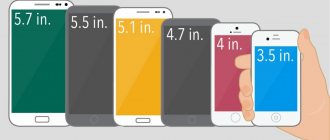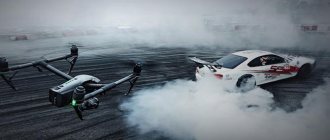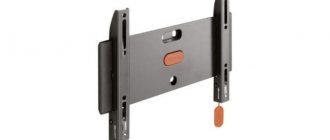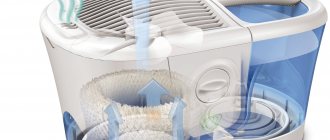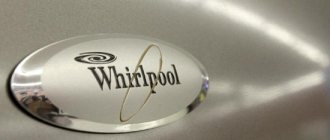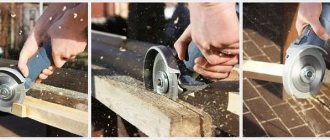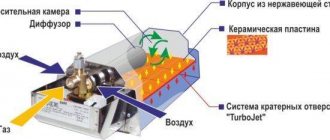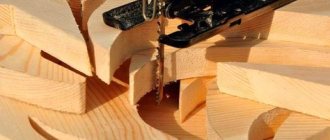When I was just starting to take my first steps in tailoring, my first sewing machine was my mother’s Soviet “Chaika”. If anyone was around this time, they probably remember these models. Their main difference from today's household sewing machines is that they operated using a foot pedal. It was at “Chaika” that I sewed my first dress, and from experience I can say that she sewed well, even now it is in working order.
Later I had to sew not only on household, but also on industrial equipment. I also sat down with various models of sewing machines from different manufacturers. And I have formed my own opinion on working with different equipment.
Unlike those times, today there is an abundance of choice of sewing equipment in stores for “dummies”. Today’s article will tell you how to choose a good sewing machine for beginners. In fact, this is the most popular question among my students, so get ready for the article to be very detailed)
Tip 2. A stitch that doesn’t tighten
The sewing machine should not make a stitch that would pull the fabric. This applies to delicate fabrics. When purchasing, be sure to make a few test stitches on pieces of fabric. Also see how the machine makes stitches on different fabrics:
- on the lungs - chiffon, silk, organza
- on medium and heavy - coat fabric, denim, linen, cotton, leather
- on elastic ones - knitwear, stretch.
Types of stitches
How to choose the number of lines
Modern sewing machines offer such a variety of stitches that even professional seamstresses do not always know all the operations and how to perform them. Judging by the reviews on the forums, it is their quantity that is the determining factor for many craftswomen. However, we believe that the standard set is sufficient for everyday use.
The most popular are straight and overlock stitches, for which a special foot is used. Zigzag is slightly inferior to them in terms of the number of uses, but it will be useful to many. The rest depends on the goals of the master.
Many machines do double and triple lines. They allow you to make the seam stronger and imitate thick thread when hemming jeans. They are used on stretch fabric to prevent tearing. Beginners don’t really need them, but in the studio you can’t do without such lines.
There are machines that store additional operations in memory: sewing on zippers, sewing buttonholes, performing plasterwork and darning. The button processing function is rarely used. To perform them, special paws are required. Most sewing machines come with options for overcasting and buttonhole sewing. The rest are not needed for beginners.
Leader VS 775E
The most functional
99 sewing operations, including overlock stitches and 8 automatic buttonholes, a table for expanding the working platform and smooth speed control - sewing on this machine is pleasant and easy. Rating participant:
5 most reliable sewing machines
Tip 3. Even stitching
If you have the opportunity to test it in action before purchasing a sewing machine, I advise you to conduct a small experiment. Give the machine the opportunity to sew on its own without your help or participation. Place a piece of fabric under the foot and watch it make a straight stitch at a distance of the width of the foot from the edge of the fabric. To see better, take threads that contrast rather than match the fabric.
Using this experiment as an example, you will immediately see what the line turned out to be. Namely, does it go to one side, does it go at the same distance from the edge of the flap. If the stitching “leads” a little, then there is a defect in the assembly of the sewing machine and when you continue to use it, you will have to contact a repairman to adjust the teeth on the needle plate. In some cases, this defect cannot be corrected and in the future, with such a sewing machine, you will have to make efforts to ensure that the stitching is even.
Middle segment (from 2,000 to 7,000 rubles)
Brother CX5
pros
- equipment;
- 5 types of stitches;
- compartment for wounding accessories.
Minuses
- only pink color.
From 5190 ₽
This sewing machine is equipped with additional feet for sewing on zippers and buttons. The set includes a foot pedal, which, depending on the pressure applied, speeds up or slows down the operation of the device. The device easily takes several layers of denim. The pressing force of the presser foot is controlled, so you can work with natural leather.
Janome 2015
pros
- works quietly;
- presence of a cover;
Minuses
- not found.
From 6578 ₽
For home use, this is the best sewing machine for a beginner in our rating. The types of stitches are drawn on the switch; there is no need to select the required mode by number. To perform uniform stitches, the shuttle compartment cover is made of metal with marked notches of sizes. The machine can sew with two needles at the same time. The sewing machine has a carrying handle hidden in the body.
Rating of Janome sewing machines according to experts and customer reviews for regular sewing.
Singer 8280P
pros
- easy controls;
- presence of a soft cover;
- performs a loop in semi-automatic mode;
- large selection of stitches.
Minuses
- noisy.
From 5825 ₽
We recommend choosing this budget sewing machine not only for sewing beginners, but also for home craftsmen. It copes with any type of fabric: denim, cotton, suede. There is a glove platform where it is convenient to store small things. In addition to straight stitch and zigzag, there is a hidden and elastic stitch. The maximum stitch length and width can be smoothly reduced or increased via the regulator.
Practicality, versatility and a basic set of sewing operations, ease and simplicity of operation, ergonomic design - you will find all this in the rating of sewing machines for the home!
Tip 4. Repairs and components
Look for a machine so that if it breaks down, you can repair it without problems. Spare parts and replacement parts should be sold in your city. Keep in mind that for expensive models all the components (foots, etc.) will also be expensive. Pay attention to the fastening of the foot. If it is unusual, check in advance where you can buy accessories for such a model.
If the model is unpopular or exclusive, then it may be a problem for you to replace the broken part. Otherwise, it will be taken out of production altogether, and the issue of repairs will never be resolved for you. Or the cost of repairs will cost the purchase of a new sewing machine.
Consult with sewing machine repair specialists in your city which machine will be easiest for them to repair. What models of sewing machines do they have experience with? For example, Janome, New Home - it’s much easier to hire them for repairs.
Patchwork and quilting machines
Quilters will appreciate the benefits offered by modern machines:
- extended surface and side table;
- upper conveyor for uniform advancement of several layers of fabric;
- special feet for patchwork and stitching;
- presser foot pressure regulator;
- quilting stitches.
Note how the bottom feed teeth can be easily disengaged to quickly switch to free-motion stitching mode. This sewing technique requires experience and precise control of the speed of movement of the fabric to obtain an even stitch. The latest Bernina models allow you to work with the BSR stitch regulator, which automatically selects the desired thread tension and stitch length to match the stitching speed.
Using this foot will provide high-quality free-motion stitching even for beginners.
We recommend Pfaff Quilt Expression 4.2
more details
| Shuttle | Peculiarity | Operations |
| Horizontal | IDT™ promotion system | 254 |
Tip 6. Sleeve platform
In order to easily get to the most difficult places in clothes with a sewing machine, it must have a sleeve platform. How can I find out if it has such a device? To do this, you need to remove the compartment from the sewing machine, which is usually located under the needle plate. Now you can easily process the bottom of sleeves, trousers, as well as armholes and necklines.
How to choose a good sewing machine for your home?
Considering the fact that we did not consider embroidery models and the product of many little-known brands, it is probably worth paying attention to a number of important parameters if you do not know how to choose a sewing machine and could not find a suitable option on our list:
- Shuttle type - the design of modern sewing machines can provide for the use of a swinging or vertically rotating type of element. The first option is attractive due to its low cost, reliability and ability to cope with coarse fabrics. The downside is the increased noise level. The vertical rotary shuttle is attractive because you don’t need to climb into the mechanism to tighten the thread.
- Loop formation can be automatic or semi-automatic. The first option reduces the user's effort to zero. Simpler models require more user time, respectively.
- Number of lines - this quantitative characteristic indicates the scope and capabilities of the technology. Today, even 25 pieces are considered the minimum.
- Number of loops – certain types of loops are used for different types of items. The higher, the easier, naturally.
- Stitch length is an important characteristic for working with thick fabrics;
- Stitch width – this parameter is responsible for the technology’s ability to work with complex types of seams.
- Additional functions - among the really useful options, judging by the reviews, the most important ones are embroidering letters of the alphabet, reverse, conveyor, as well as a sleeve platform.
Tip 7. Ruler on the needle plate
When purchasing, make sure that there is a ruler on the needle plate of the sewing machine, which will allow you to sew exactly the amount of allowance that you set when cutting. Example in the photo - I sew a stitch 1 cm away from the edge. The edge of the fabric on the right is located at the 1.0 mark. This device greatly simplifies the sewing process and speeds it up significantly!
Tip 8. Which sewing operations are really needed for work?
You must decide for yourself which sewing functions your machine should have - which you cannot do without. If you plan to sew simple things at home and do minor clothing repairs, then a machine with a basic set of functions :
- Straight stitch. You need to choose a sewing machine that makes a perfectly straight stitch.
- Zigzag stitch. It is needed for processing open sections of fabric to prevent it from fraying. Please note that the machine has the ability to adjust the width of the zigzag.
In addition to these two main stitches, you may also find useful sewing stitches such as:
Elastic zigzag for sewing elastic
Stretch stitch for knitwear
Reinforced straight stitch
Reinforced zigzag
Edge stitching, if you do not plan to pay for the machine - overlock
Invisible hem stitch
Stretch stitch for invisible hem
- Buttonhole processing function. With automatic mode, or semi-automatic - depends on your financial capabilities. You can make a quality loop in both modes.
- Reverse function (reverse). Necessary for making backtacks at the end of a stitch.
If you are not short of money, buy a sewing machine. Then you can consider additional functions in the machine that will also make your work easier:
- Regulator of presser foot pressure on fabric. It will come in handy when you sew fabrics of different thicknesses: chiffon or drape. There is a manual regulator - this is a disk or a screw, and an electronic one on computer machines.
- Spot tack. This will come in handy so you don't have to tie a knot every time you finish a stitch.
- Decorative stitches. Needed when placing various types of finishing stitches on clothes.
When purchasing, please note that the sewing machine includes the following parts:
- foot for sewing a regular zipper (single-arm)
- concealed zipper foot
- Teflon foot for working with leather
- roller hem foot
- assembly feet
- foot for sewing bias tape
- Needles
- Lubricating oil
Don't be upset if some components are missing. You can always buy the missing paws and needles. In addition, you may not need some additional details in your work.
How to choose correctly
The first step is to decide what the machine will be needed for. If for simple operations: hem trousers, sew curtains, remake children's clothes, make a costume for the New Year tree, then you can get by with a basic set of functions that every modern machine has.
If you plan to take your hobby to a professional level in the future or to delight yourself with realized fantasies, then it is worth considering options with a large number of operations and additional opportunities.
Once the purpose of the purchase has been determined, it doesn’t hurt to know how to choose the right one.
Tip 9. Which machine is better to choose: computer or electromechanical
If your sewing machine has a computer unit, but it makes ugly straight stitches, then of course this is a reason to think about it. In favor of electromechanical, but at the same time better quality in work. Therefore, before purchasing, be sure to check the product in operation: the stitching should not wobble, all stitches should be the same length and not pull the fabric when sewing.
If you choose a computer sewing machine, you will need to handle it very carefully. Do not use it continuously for a long time. For example, for industrial purposes, for an atelier. The computer unit has the unpleasant property of overheating and subsequently failing.
Advantages and disadvantages of different types of shuttles
| Shuttle type | Advantages | Flaws |
| Vertical | - Reliable; — Rarely breaks; - Works well with thick fabric. | - It's noisy. |
| Horizontal | — Has a large selection of stitches; - Does not tangle or break the thread; — It works quietly, — You can always see how much thread is left. | — Doesn’t cope well with thick and coarse thread. |
If you have to work a lot on the machine, then it is better to choose a vertical shuttle - a rotary one; if the work is only for yourself and your family, then preference should be given to a horizontal shuttle.
Tip 10. How to choose a sewing machine with an overlock function
The overlock function in sewing machines has appeared recently. This is a two-in-one model: a classic sewing machine and an overcasting machine. But don’t rush to rejoice if you decide to save money on buying an overlocker for your home. Because the “two-in-one” model only imitates an overlock stitch.
Externally, the stitch will look like an overlock stitch, but in terms of quality it clearly does not match the original. The strength is not the same. Essentially, a sewing machine with an overlock function is just a type of zigzag stitch.
Of course, two-in-one models will cost double the price. Is it worth paying extra for a separate stitch? If you sew for yourself and do not work for clients who care about the inside of their clothes, then a classic machine with a zigzag function will be enough for you.
Well, if you are a perfectionist and love a beautiful backside, it’s better to save up for a separate overlocker and don’t waste money on a sewing machine with an overlocker function.
Advice>>> How to save money on buying an overlocker? Buy an overcasting foot for a sewing machine. Or look at the tool compartment from your sewing machine; perhaps you already have one in your kit. It will create a zigzag seam more neatly than with a regular foot, especially when sewing delicate fabrics and knitwear. The edge will not curl or pinch as it usually does when overcasting. It also helps to produce high-quality finishing stitches, such as double parallel stitches on jeans. It is especially useful for beginners in sewing, when you are just learning how to make even stitches on fabric. Where can I buy a foot like this? I saw it on Aliexpress, and it is also available in sewing equipment stores.
The best machines are those on which you can sew everything.
Electromechanical sewing machine Bernette Milan 5
Electronic sewing machine Brother Innov-is (NV) 10
Typically, customers come for a sewing machine, which can be used to sew not something fancy, but to perform standard operations - hem curtains, hem jeans, sew a children's suit. A good sewing machine with a suitable set of functions can be found even in a low price category. If we consider several brands, these are Aurora 525, Brother Innov-is (NV) 10, Janome Decor Excel 5024, Bernette Milan 3, Bernette Milan 5, etc. All of them have several working lines, among which the most important are “straight” and “zigzag”, as well as “overlock” and “automatic buttonhole”. You must understand that in models of different brands the functions are repeated, and needlewomen who are accustomed to using equipment from one brand will never exchange it for another.
Tip 11. What type of bobbin thread should you choose?
Which shuttle is preferable to choose, with horizontal or vertical filling? By making it possible to choose, sewing machine manufacturers have made the purchasing task more difficult for a beginner. The seller can tell you that you can take any, but there is still a difference, and now I will share with you exactly what it is. Machines with a horizontal shuttle are more functional, they have more lines used in work. And the vertical shuttle is more reliable, it breaks down and fails less often. In addition, you should proceed from your needs; if you plan to sew thick, heavy coat fabrics, then a vertical shuttle is best suited for these purposes.
Beginner's Choice
Those who will occasionally sew and repair clothes do not need dozens of lines and complex settings. A machine for teaching basic craft skills must also be easy to operate.
Equipment for home and infrequent use should be:
- reliable;
- for all types of fabrics;
- with overlock and elastic seam.
If you sew bed linen, covers, curtains and other accessories, you can consider options without overlock seams. Pay attention to models with a side table and good stitching of thick fabrics. For such work, there is no significant difference in which shuttle will be installed on your machine:
- The horizontal shuttle is easier to thread and allows you to see when the lower thread is coming to an end. It does not require frequent lubrication and, according to reviews, feeds the thread more smoothly;
- the vertical shuttle is more reliable because it does not include plastic parts, and its replacement or repair will be much cheaper.
How to choose a quiet sewing machine?
The noise level depends not so much on the shuttle, but on the totality of the characteristics of each model (including build quality). Our reviews show that the quietness of machines with a horizontal shuttle is not confirmed by tests. If quiet running is important, refer to the specific values and feedback provided in real reviews.
Please note that the number of operations is not equal to the number of lines! In the simplest models there is no manual adjustment of the stitch length and zigzag width. A straight stitch with different lengths will be written as several operations (as well as a zigzag with different widths), but in fact these are only two types of stitch.
The optimal number of operations for beginners is up to 18. A larger number is usually achieved by adding decorative stitches, which are practically not used.
The needle threader is useful for people with low vision and will help you easily thread the upper thread into the eye of the needle.
The hard case is useful for frequent trips to the country or for secure storage.
Watch reviews of sewing machines →
For ease of use, you can pay attention to machines with a needle threader and a hard case for storage and transportation, for example, to the countryside. The cost of sewing machines for beginners is not high and depends on the number of operations, adjustments and configuration. It is necessary to distinguish between sewing operations and types of stitches. If the sewing machine does not have adjustment of the length or width of the stitch, then with an equal number of operations, in such models, there will be many times fewer types of stitches, compared to machines in which the length and width are set by special regulators.
A large number of types of stitches or operations are achieved, as a rule, through decorative stitches, which are very rarely used in everyday life. Therefore, a sewing machine that performs 14-18 types of stitches is the optimal solution for a beginner. As for the brand, pay attention to the most popular: Janome, Elna, Pfaff, Husqvarna, Bernette and Brother.
We recommend Bernette B33
more details
| Shuttle | Operations | A loop |
| Vertical | 15 | Semi-automatic |
For beginners, a simple sewing machine with a small number of operations is suitable, but an overlock stitch is required. A needle threader and hard case are welcome.
Tip 12. What is the difference between a household sewing machine and an industrial one?
These are two large groups into which all sewing equipment can be divided. The answer to the main difference between a household machine and an industrial one lies in the name itself. A household machine will not handle the amount of work and complexity that an industrial model can handle.
But an industrial machine performs only one operation. While the household one combines many functions: straight stitch, zigzag, loop processing mode. But at the same time, an industrial one will make hundreds of thousands of stitches per day and will not overheat. The durability and reliability of industrial machine parts is designed for decades of use.
A sewing machine for beginners should be chosen from the group of household machines. The reason for this is the high speed of industrial equipment. If you are just learning to sew, you may not be able to cope with a sewing machine that makes 5 thousand stitches per minute. The main danger for beginners when working with an industrial machine is injury. You can easily stitch your fingers.
In addition, an industrial machine will be too noisy for a home. Based on prices, household sewing machines are more budget-friendly and for beginners it is better to start learning to sew with them.
What types of sewing machines are there?
There are many not only models, but also types of sewing machines. We will not consider industrial ones; we will focus on modern household ones:
- Electromechanical. These are the most common and easy to use machines. The undeniable advantages of this type are low price, reliability, durability, low cost of repairs in case of breakdown. This type is great for beginners and those who want to have an assistant in the house for minor repairs and occasional use. You can sew curtains and a dress on it, sew up a hole, and so on. The price category of these devices is usually from 3 to 10 thousand rubles.
- Computer controlled. This device has a larger number of programs and its own software. The model's skills directly depend on memory and the number of programs. At first glance, this “sewing computer” is an excellent multifunctional thing. But if you look closely, it is not really needed in everyday life. You will try most of the numerous stitches only after purchase, but will not use them. Overlock, straight stitches and zigzags, and sewing buttonholes will be useful. One of the advantages is the speed and accuracy of work. This unit is suitable for seamstresses who do this professionally and sew to order. But the downside is the price of the machine itself and possible repairs. The cost of such machines is 2-3 times higher than previous ones.
- Sewing, embroidery and embroidery. This is a machine that can handle not only regular stitching, but also embroidery of various patterns. But unfortunately, everything is not as rosy as we would like. There are very few programmed embroideries, and to get more of them and to be able to create your own patterns, you will have to buy other software, which is quite expensive. Also, don’t think that by purchasing such a device, you will immediately start creating magical patterns. Machine embroidery is an art that needs to be learned. It's not so easy to convey your desires to a computer. This machine is suitable for those who have decided to take up embroidery and spend time learning, but who are not going to forget about sewing (stitching/hemming).
- Overlockers. It can be useful for regular sewing activities. The machine processes the edge of the product, cutting off excess allowance. This significantly saves time when dealing with large volumes of work. But if you rarely sew, then you can use the overlock function on a regular machine. The difference is the neatness of the seam and the lack of automatic cutting. The price is usually from 6 thousand rubles and above.
- Quilting. They're flat-seamed. The purpose of this device is to process cuts of knitted products. Only they and carpet lockers can handle this kind of work. It is very difficult to process knitwear with a regular seam, and it will not do any good. But with such a machine you will get an elastic stitch that will prevent the fabric from unraveling and the seam threads from breaking when stretched. The cost of the unit is within 15,000 rubles. If you are going to sew T-shirts, swimsuits and stretch dresses, this is for you.
- Coverlocks. This is a symbiosis of the two previous types - an overlocker and a cover stitching machine. Designed for working with knitwear. The models cost the same as two devices separately, so here the question of convenience arises more. Sometimes it's easier to work on two different machines than to constantly reconfigure one.
So, which sewing machine should you choose? For a beginner, of course, it is better to buy a regular electromechanical model. Or buy a computer if you plan to make money from a craft.
Now let's take a closer look at what to look for when choosing a model, and what is just a marketing ploy.
Tip 13. Which brand of sewing machines to choose for beginners
Sometimes it happens that different manufacturers produce machines that are identical in quality and feature set. But these products can vary greatly in price. Therefore, in order not to overpay for the brand, choose sewing machines based on the price-quality ratio.
Pfaff, Husqvarna
- quite expensive models. If the car is exclusive, repairs will cost you a pretty penny.
Brother
— according to reviews, it has an uncontrollable pedal, makes poor-quality stitches
Janome
- the most optimal balance of “price - quality”. According to reviews from customers and my students, it has the highest ratings.
Astralux
— according to reviews, it is impossible to achieve high-quality stitching on thin fabrics with this machine. It also does not have a very high operating speed.
Selection options
We have already looked at the types of control and even decided which one is preferable for different tasks. Now let’s take a look at the main characteristics that will help you choose a specific sewing machine model.
Stitches
Here it is important to choose the optimal number of working and decorative stitches, and the manufacturer will provide their variety. In the simplest models of machines, even standard seams for joining fabric will be at least 5 - enough to solve any everyday problems. The main thing is that among them there are:
- straight stitch;
- overcast;
- secret;
- elastic;
- zigzag.
If you have to work with different types of fabrics or occasionally perform non-standard tasks, you can take a machine with 10-20 types of stitches. This is definitely enough for beginner craftswomen.
Decorative and embroidery stitches are for professionals. If you fall into this group or plan to do super complex stitches and machine embroidery in the near future, look for a computerized model with an embroidery unit. In any case, experienced needlewomen should choose a technique according to the principle: the more types of stitches in the program, the better.
Buttonhole sewing
This function is available in almost all modern models, but the method of making buttonholes can be different: semi-automatic or fully automatic. In the first case, you will have to “help” the machine do its job by turning the product in the right direction - each loop is swept in 4 stages.
Professional models have an automatic option - faster and more convenient. Such advanced machines can sew from 3 to 10 different loops, including the most complex of them - with an eye. Accordingly, they are more often used in ready-made dress ateliers, and for home use, one mode of a standard linen loop is enough.
Shuttle type
A lot depends on its design, so before purchasing, always check what type of shuttle device is installed in your model.
The swinging shuttle is the simplest option found in mechanical and inexpensive EM machines. It is noisy, not very fast and does not allow stitches longer than 5 mm. At the same time, the quality of the stitching, like the shuttle itself, can “float”, and thread breaks are not uncommon here. Threading the lower thread and adjusting its tension in this case is also quite difficult, but the cost of the machine itself will be low.
A horizontal (rotating or rotating) shuttle is a more advanced design that is found on machines with an upper bobbin. It is already built into the body and does not swing, but wraps around an axis, reducing vibrations during operation. Another advantage of this solution is that the lower thread practically does not get tangled, which improves the quality of the seam. Alas, adjusting its tension in this case is also difficult, but it is easier to control the supply of thread on the bobbin. The horizontal shuttle allows you to get a line up to 7 mm long and a wider zigzag up to 6 mm.
Vertical shuttle - boasts high reliability and does not tangle the thread during operation. The main difference from the horizontal one is the simple tension adjustment. This function is necessary for seamstresses who constantly work with fabrics of different thicknesses.
Basic adjustments
Sewing speed is an adjustable parameter. In the simplest electric machines, it can be controlled by pressing the pedal: the deeper you press it, the faster the stitches fall. But if you spend all day at the sewing table, this is not very convenient. It is better to look for a model that starts with a button, and the speed is set on a separate regulator or is automatically adjusted by the program. In professional machines it can reach 1300 sti/min, but this is the level of experienced craftswomen. Usually 800-850 sti/min is sufficient.
Piercing force is often directly related to sewing speed - this is how the laws of physics work. When purchasing the simplest EM models, you can focus on the power of the unit itself - the higher it is, the easier the needle will pierce thick fabric. Semi-professional machines usually have 70-80 W motors installed. If this figure is lower, then you can only work with thin materials. In more expensive models, the puncture force is already regulated by the operator or the machine itself thanks to the built-in electronic stabilizer.
Presser foot pressure – here it is also better to opt for an adjustable or adjustable pressure, as in professional computerized models. This will make it easier to work with fabrics of different thicknesses without losing stitch quality.
Tip 14. Where to buy a sewing machine
Nowadays it is not a problem to buy a sewing machine. Now it is possible to compare products at prices in different stores. There are several ways to get yourself a home assistant.
Method 1. Internet. Many large hardware stores have websites; you can go to the website of such a company and view the offers of online stores. Don't worry that you won't be able to test the machine in action. Such stores have a warranty period during which you can return the sewing machine.
Method 2. Through specialized stores. In any large city there are shops selling sewing equipment. You can find them through the Double GIS application. In the field of activity column, type “sewing equipment” and organizations engaged in the sale of household (industrial) sewing machines will appear.
These stores employ specialists and craftsmen who can help you make the right choice based on your experience. They also give advice on working and caring for the machine.
Method 3. If you have a limited budget, then you can buy an inexpensive sewing machine on Avito. There you can buy a used sewing machine for half the price than in stores. To reduce the risk of buying a pig in a poke, take a person with you to the transaction who has experience working with sewing equipment.
Types of sewing machines
Modern sewing machines, despite the fact that they perform approximately similar tasks, are divided into 3 large families according to the type of control. This is convenient, since the number of operations that the equipment is capable of primarily depends on the implemented system.
We will not consider obsolete mechanical models - their functionality and speed cannot be compared with the capabilities of more advanced units. Let's look at the current types of sewing machines.
Electromechanical
What distinguishes this type of unit from its ancestors is the electric motor, which drives the flywheel, freeing both hands for the seamstress. And she will need them, since all the settings will have to be set manually using levers and handles located on the body.
Pros:
- Simplicity and reliability of design;
- A sufficient, although not the richest, set of functions (usually no more than 20);
- Good maintainability, easy maintenance;
- Affordable price.
Minuses:
- It will take time to master and remember all the adjustments;
- Minimum decorative stitching.
Electromechanical machines are required to do only one thing: automate hand sewing. This technique is suitable for simple household tasks, when you need to repair clothes, trim kitchen towels or curtains, sew some accessory or a simple item.
Electronic
Cars “with a brain”, the role of which is taken on by the control microprocessor. Its memory stores programs for lines of different levels of complexity, as well as all the necessary adjustments. Such models are equipped with a display on which you can monitor the operation of the machine and set basic sewing parameters.
Pros:
- The ability to perform a large number of different stitches up to simple embroidery;
- Easy to operate – just select the desired operation on the control panel;
- A set of automatic settings that do not require operator intervention;
- Availability of a display with information about the current mode or with hints;
- Many models are started with a button rather than a pedal.
Minuses:
- Demanding quality of current in the network;
- Difficulty in self-repair.
This is the largest and most diverse family of sewing machines with rich functionality - there is equipment for professionals and beginning craftswomen. With its help, you can create items of any complexity from a variety of fabrics, sew buttonholes and buttons, decorate your models with decorative stitches, applique and even embroidery.
Computer controlled
The most advanced models, surpassing even electronic machines in their functionality. In addition to their own software control, they can connect to an external PC and operate with virtually no operator intervention. The design of computerized machines is also different. So that one unit can perform hundreds of different operations, the main groups of mechanisms are equipped with separate drives (sometimes up to 10 motors) and are capable of operating autonomously.
Pros:
- The largest set of functions (on average up to 500 different operations);
- Expanded possibilities for designing loops, including eye loops;
- Creating your own, unique stitches;
- Automatic selection of modes depending on the fabric;
- A sewing assistant who helps you choose a foot, needle and other devices for a specific task;
- Most machines are equipped with an embroidery module;
- Some models work with memory cards.
Minuses:
- Very high price.
The purchase of computerized sewing equipment is justified in cases where the sewing of complex and exclusive items is put on stream.
Tip 15. Sewing machine price
A very common question among those who choose sewing machines is: Why are some models expensive, although machines from another brand with the same characteristics are half the price? Would it be better to make stitches with a machine that is more expensive? Here, first of all, you need to pay attention to the following points:
- Internal contents. Different manufacturers have different requirements regarding the quality of parts. Cheap appliances may be equipped with plastic parts, while a more expensive brand may have special quality control at the factory.
- Even if at first glance you have machines in front of you that have the same functions, they can do it in completely different ways. One manufacturer can seriously invest in developing models, speeding up the process, and using the latest developments in technology. And the other is to do everything the old fashioned way, which of course will affect the low cost.
- Advertising. It is no secret that some manufacturers invest their advertising and product packaging costs into the price of sewing machines. After all, in order for people to talk about her, you need to talk about her, right)
And finally, I can say with the famous proverb that a miser pays twice. This also applies to sewing equipment. If you plan to use your assistant every day for a long time, then it is better to take a high-quality one with good filling. Otherwise, you risk spending twice as much on repairs and components. Also plan to purchase from an authorized dealer with support, this means that you will not be abandoned in the event of a breakdown or with spare parts.
The best inexpensive sewing machines for beginners
VLK Napoli 2200
pros
- modest dimensions;
- operation from mains or batteries;
- presence of backlight.
Minuses
- does not take thick fabrics
From 1139 ₽
Anyone who has decided to choose a sewing machine for beginners: a child or a young girl, should pay attention to this model. The package includes two bobbins, a needle, a connection cable and a foot drive. You won't have to buy anything. The control buttons are large and located on the front. Instructions in Russian with photographs illustrating the threading process. There is illumination of the working area. The machine sews well and takes thin fabrics without any problems.
irit IRP-01
pros
- equipment;
- dimensions;
- presence of 2 operating speeds.
Minuses
- difficult to thread;
- makes a lot of noise.
From 800 ₽
The cheapest sewing machine in the ranking. Suitable for hemming pillowcases or mending linen. The seam is good, strong, a little stretched. We advise a beginner to choose this sewing machine for working in a house or apartment, but only without small children. The device is very noisy and may frighten them. However, she confidently copes with simple tasks. The machine operates both on mains power and on AA batteries.
FIRST AUSTRIA FA-5700 Green
pros
- design;
- average power;
- light weight.
Minuses
- short stitch length.
From 1192 ₽
In order not to be disappointed in the purchase, you need to not only buy a sewing machine for beginners, but also take care of the components for it. There are few additional accessories included with this model. You will need to purchase threads, replacement needles and presser feet. The device, according to the owners, sews light fabrics well. The machine can even operate on AA batteries. Charging it is not difficult. Even a beginner can handle a horizontal shuttle.
What sewing machine do I use now?
I have a Family machine on my desk. This is the most common inexpensive sewing machine with a minimal set of functions. From experience, I can say that I use only two lines on it - straight and buttonhole mode. No need for work anymore. Unless, of course, you make quilts or do patchwork. I have been sewing on it for ten years, and with proper care, such an assistant will last you just as long.
I also have another sewing machine - a carpet lock. I use it for overcasting the edges of clothes and when sewing knitwear.
Therefore, my main advice to you is that the simpler the sewing machine model, the more convenient it will be for you to understand it. In everyday life, for sewing at home, one sewing machine is enough, which makes a beautiful straight stitch.
Electronics for complete pleasure
And now we move on to even more “smart” and safe-to-use machines that beginners can easily operate. For example, Bernette Sew&go 8 and b38, which have almost all the amenities, one of which is speed control. It is possible to sew from a button, the so-called “pedalless sewing”. It allows you not to press the pedal with your foot, but to calmly touch the indicator with your finger, and the car will smoothly pick up speed. Thanks to these characteristics, these cars are readily purchased by people with disabilities.
In addition, they come with a large selection of paws. For beginners, these are universal machines that can be used for any sewing and even patchwork. The machines have several decorative stitches, and the b38 model has an alphabet that allows you to embroider inscriptions. As you know, your “appetite” grows while you work, and before you even start sewing, you will want to create more and more diverse products, decorating them with new stitches and patterns.
Electronic sewing machine controls
Finally
Mistakes at the beginning of learning to sew are inevitable, and when because of them the thread constantly breaks and the needle breaks, the mood can be ruined and the desire to sew will disappear for a long time. Therefore, especially emotional people should choose an “obedient” and “patient” sewing machine that will reliably protect you, and most importantly yourself, from your mistakes. These machines include electronic versions.
They block the action if something is done incorrectly and report an error code. They will also delight you with a wide range of technical and artistic capabilities. After all, the main thing for needlewomen, and especially for beginners, is to enjoy their work.
Return to articles
Online cutting and sewing courses for beginners video - lessons
If you have purchased a sewing machine and don’t know where to start, I have online cutting and sewing courses for beginners:
1) Design - this course is suitable for those who want to learn how to create patterns and take measurements of a figure. To successfully pass here you do not need to be an ace in drawing or have any special skills, the information is presented easily and simply
2) A basic course in cutting and sewing is the basics. I suggest taking it to all beginners who are in search of sewing knowledge and don’t know where to start. This course was pieced together from my offline (live) sewing courses, which I have been teaching in the city of Ufa since 2014. I know at what stage students may have difficulties, so I can help you
3) Course on sewing pajamas and underwear This course was born in the process of working on master classes on home clothes, when I saw that my interest in it deserves separate training. In this course we sew using ready-made patterns, so it is perfect for complete beginners who are still afraid to delve into the processes of constructing patterns. Honestly, you can even take this course with your children, because it is interesting, and you can get results very quickly!
Shuttle type
How to choose the right shuttle type
The shuttle type determines the use of the device. This largely depends on personal preference and the operations being performed. The shuttle is a hook that wraps a loop of upper thread around the lower thread, moving near the bobbin. The formation of the seam depends on this.
Any type of shuttle is capable of making an even stitch. But there are 2 characteristics that greatly simplify the task. The shuttle category depends on them.
Movement type
This parameter determines exactly how the shuttle forms the stitch. There are 2 ways: rotation (rotational) and oscillation (oscillating). The latter first moves in one direction, then in the opposite direction. Rotary turns around the bobbin.
Any type of shuttle will tangle the threads and ruin the work if the seamstress makes a mistake. Judging by the reviews of craftswomen, there is no such device that will automatically do everything for the master. Therefore, the choice here depends on the personal preferences and skills of the seamstress. Any shuttle requires practice; at first, the threads turn out to be tangled. Both types are suitable for home use.
Shuttle orientation
The shuttle can be vertical and horizontal. The first one is inserted into the back or side of the machine, facing forward. Some beginners find it difficult to learn the technique and blame the design of the device. However, the reason is in the approach. The horizontal position means that the bobbin is inserted from the top. However, the thread must make a 90 degree turn, which requires skill. As a result, you will have to get used to any orientation, and professionals really don’t like to relearn. A vertical shuttle is suitable for most people, as it is less demanding on the quality of the threads.
